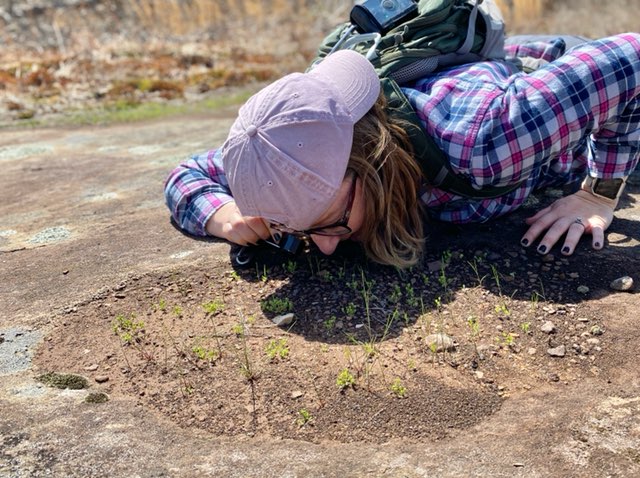
Inspecting Geocarpon minimum, Photo Credit: James Faupel, Missouri Botanical Garden
Comprehensive Rare Plant Translocation Records
Reintroduction is a popular tool for the conservation of rare plants in the United States. Over the past 30 years, conservation officers working with the CPC have conducted over 140 plant reintroductions and other conservation translocations across a diversity of species and habitats. The reintroduction process generates an abundance of valuable information which can be utilized by managers and scientists to inform the planning and implementation of future projects. However, locating and gaining access to this information can be onerous and time-consuming, since relevant documentation is scattered widely, or remains in unpublished reports. The CPC Reintroduction Database (CPCRD), a centralized and standardized repository, addresses this problem by organizing data on 55 fields of information designed to advance both the science and practice of plant reintroductions. The CPCRD covers the key stages of a reintroduction, from the planning and implementation phases, to monitoring and management techniques, while also collecting information on the ecology and biology of outplanted taxa. Existing data in the CPCRD has been aggregated from multiple sources (see the User Handbook for details on data collection), while data on new reintroduction projects, or additional data on projects already in the database, can be added via one of the CPC’s Reintroduction Project submission forms. To learn more about the CPCRD and rare plant reintroduction practices in the United States, check out our recent article published in the journal Applications in Plant Sciences: Bellis, J., Albrecht, M.A., Maschinski, J., Osazuwa‐Peters, O., Stanley, T. and Heineman, K.D., 2024. Advancing the science and practice of rare plant conservation with the Center for Plant Conservation Reintroduction Database. Applications in Plant Sciences, p.e11583. https://doi.org/10.1002/aps3.
Database Statistics
Data Contribution and Access
Access to the CPCRD is limited to vetted data contributors, in accordance with the data policy agreement set out during the data collection phase. You can contribute data on a rare plant reintroduction project by registering an account with the CPC and filling in the Reintroduction Project Submission Form. Once your form has been submitted, you will be able to update your project as it progresses by completing outplanting and monitoring event forms. If you would like to see which projects are already included in the CPCRD, along with details on project type, year of first outplanting, lead institution, and other useful filtering information, head over to the CPC’s Reintroduction Registry page. If you are planning a rare plant reintroduction in the US, you can apply for view-only access to the full database as a ‘future contributor’ by registering the name of your focal taxon and your institutional affiliation with the CPC (please see the CPCRD data use policy for more details). We also encourage those who are planning a reintroduction to read the Reintroductions and Other Conservation Translocations chapter of the Center for Plant Conservation Best Plant Conservation Best Practices to Support Species Survival in the Wild, which present a logical framework that covers all aspects of a reintroduction program and that is generalizable to most plant species, geographic locations, and ecosystems.


